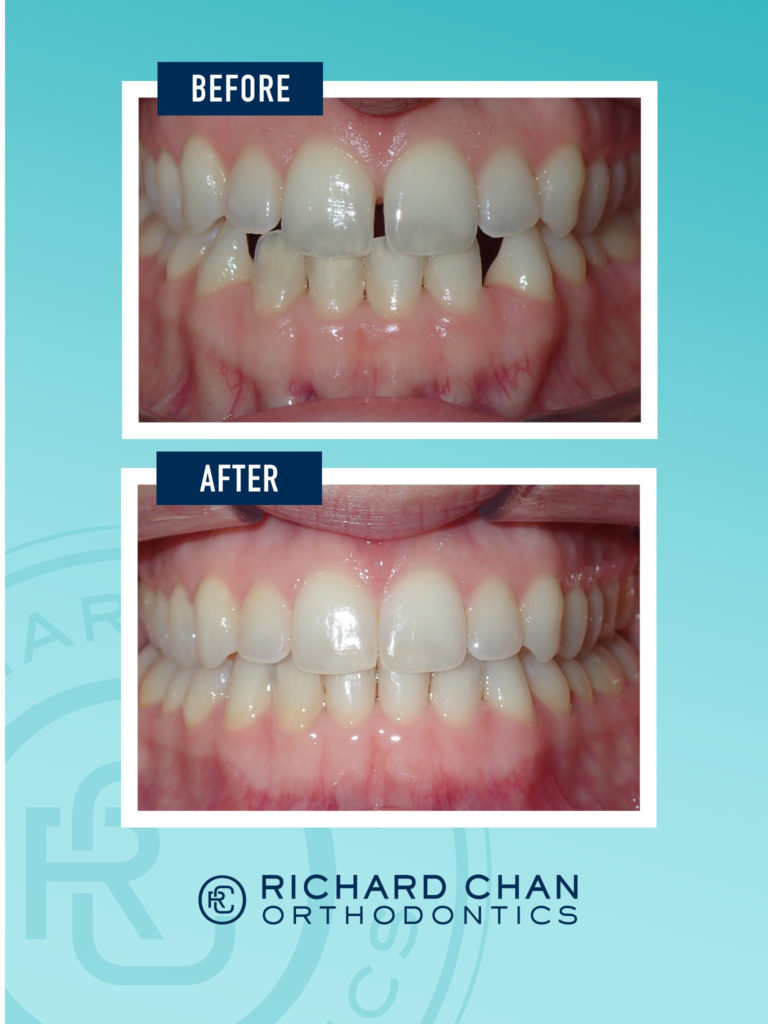
Common Teeth Problems Diagnosis
Can I get braces for an anterior crossbite? Can Invisalign fix an overbite? We get a lot of questions like these from our Alaska, Bothell, Monroe, Mill Creek and Everett, WA Invisalign and braces patients before they start treatment. As a certified specialist in orthodontics, Dr. Richard Chan specializes in diagnosing, preventing and treating malocclusions, or problems with the size, positioning and alignment of the teeth and jaws. Of course, orthodontic treatment is focused on straightening the teeth and creating a beautiful smile for every patient, but we also want to design the most functional bite (how the upper and lower teeth fit together). While each patient is unique and you could even have a combination of problems, these are the most common bite issues we address.
What is Crowding?
Crowding happens when there isn’t enough room in the jaw to fit all of the teeth. As a result, the teeth may twist, overlap or stick out in an effort to squeeze in the limited space. Crowded teeth are harder to keep clean, which increases your risk of developing tooth decay and gum disease. Crowding is commonly the result of primary teeth falling out too early or it can be related to the tooth to jaw size relationship.
For many cases of crowded teeth, we can get great results with metal braces, clear braces, Invisalign® or Invisalign Teen. At Richard Chan Orthodontics, we treat conservatively and avoid extractions unless they’re absolutely necessary. For severe crowding, if we are able to treat it early while a patient is still growing, we may be able to expand the jaw using appliances so that there is enough room for the permanent teeth to come in properly. Other times, in addition to braces or clear aligners, we might have to recontour the teeth to make them the right size.
What is Spacing?

What is an Underbite?
When the lower teeth sit in front of the upper teeth, it’s called an underbite. Underbites are another one of the common teeth problems that happen when the upper and lower jaw grow at different rates. Having an underbite may lead to a number of problems, including issues with chewing and speaking and even sleep apnea. Since an underbite is typically skeletal in nature and related to jaw growth, early evaluation is beneficial.
When it comes to how to fix an underbite, if we begin treatment when a patient is growing, we can use special appliances to advance the jaw and upper teeth and then fine-tune the smile with braces or Invisalign. For a severe underbite in an adult patient, surgical orthodontics might be the best course of action. This is where corrective jaw surgery is combined with orthodontic treatment to advance the jaw and align the teeth. However, because of advances in diagnostics, treatment planning and the treatments themselves, underbite surgery is becoming less common and there are times when we can fix an underbite with orthodontics alone.
What is an Overbite?
An overbite is when the top front teeth stick out too far in front of the bottom teeth. An overbite can cause excessive wear of the enamel, make the top teeth more susceptible to injury, cause undue stress on the jaw joint and lead to jaw pain, or give the appearance of a gummy smile. An overbite is usually genetic.
Patients often ask, can Invisalign fix an overbite? Many times, yes. How to fix an overbite depends on the severity. For a mild or moderate overbite braces and Invisalign will often be effective in treating it and creating a healthy bite. In cases of a severe overbite braces or Invisalign alone might not be enough. Sometimes jaw surgery is necessary to correct the most severe overbite problems, and Dr. Chan will discuss this option with you.
What is a Crossbite?
So, what is a crossbite? A crossbite is when some of the top teeth are behind the bottom teeth. If the back teeth are involved, it’s called a posterior crossbite, while if it occurs in the front of the mouth, it’s called an anterior crossbite. The causes of a crossbite include genetics or certain oral habits, such as prolonged thumb sucking. It’s important to treat a crossbite because patients will often compensate for their crossbite by moving their jaw to one side or forward, which can lead to permanent changes in their facial structure.
If you have an anterior crossbite braces or Invisalign can usually fix it. To correct a posterior crossbite, sometimes, Dr. Chan may use appliances to expand the upper jaw followed by treatment with clear braces, metal braces, Invisalign or Invisalign Teen.
What is an Open Bite?
A patient is said to have an open bite when the upper and lower teeth don’t touch at all when the jaws are closed. An open bite can interfere with your ability to chew and speak properly. Genetics or habits like tongue thrusting and aggressive pacifier or thumb sucking can cause an open bite.
How we treat an open bite really depends on the case. If it’s caught early on, Dr. Chan might use appliances first and then braces or Invisalign to help the teeth come together correctly. For adults, there are times when braces or Invisalign alone or in conjunction with extras like rubber bands can fix an open bite. In rare, severe cases, jaw surgery combined with braces or Invisalign could be necessary.
What is Upper Front Teeth Protrusion?
Upper front teeth protrusion is the technical way of saying the top front teeth stick out. This is a highly repetitive common teeth problems that cause the upper front teeth might stick out because they’re positioned too far forward or because the bottom teeth are too far back. It puts the front teeth at greater risk of being injured. Dr. Chan can shift the top front teeth back and out of harm’s way using metal braces, clear braces or clear aligners.
If you’re concerned about a bite problem, schedule a complimentary consultation with our Alaska, Monroe, Bothell, Mill Creek and Everett orthodontist Dr. Richard Chan today. Using a high-tech approach and modern treatment options, we can help you get a healthy, beautiful smile and overcome common teeth problems. Social distancing or just really busy? For your convenience, we also offer virtual consultations!
